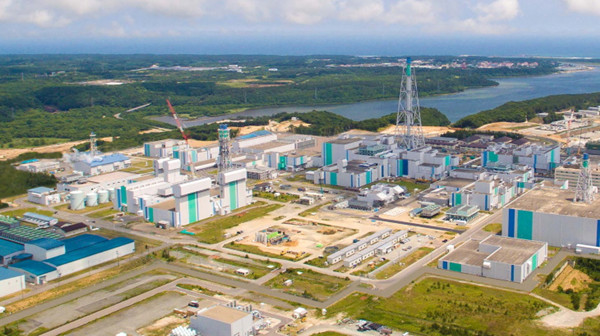Regulator confirms safety of Japanese reprocessing plant
Japan's Nuclear Regulation Authority (NRA) today approved a draft report concluding Japan Nuclear Fuel Limited's (JNFL's) reprocessing plant at Rokkasho in Aomori Prefecture meets new safety standards. The approval brings the plant, construction of which began in 1993, closer to starting up.

The Rokkasho used fuel reprocessing plant (Image: JNFL)
Following the March 2011 accident at the Fukushima Daiichi nuclear power plant, new safety standards for nuclear fuel cycle facilities came into force in December 2013. The requirements vary from facility to facility, but generally include reinforcement measures against natural threats such as earthquakes and tsunamis, and in some cases tornadoes, volcanoes and forest fires. Reprocessing plants need to demonstrate these as well as countermeasures specifically for terrorist attacks, hydrogen explosions, fires resulting from solvent leaks and vaporisation of liquid waste.
The NRA today approved a draft report saying that the Rokkasho reprocessing plant meets these new safety standards. It set a one-month period to solicit feedback from industry minister Hiroshi Kajiyama and other parties concerned.
"We believe the facility's design ensures high safety margins against possible accidents," NRA Chairman Toyoshi Fuketa was quoted as saying by Jiji Press. "The [seismic] faults near the facility were sufficiently examined and the screening was conducted adequately."
At the Rokkasho plant, additional equipment and systems are being installed for the recovery of radioactivity in the event of a severe accident. An evaluation is also being carried out of the impact on control devices and equipment in the event of a leak of high-pressure and high-temperature steam, and the development and installation of relevant countermeasures, if deemed necessary. A new emergency control room is also being constructed at the plant. Additional safety-related countermeasures are also being put in place, such as internal flood protection, strengthening of the seismic resistance of pipework, improving cooling water tower resistance against tornadoes and improving measures against internal fires.
In a statement, JNFL said: "The acceptance of the draft examination is a big step forward for us today, and we will continue to make every effort to pass the examination."
Construction of the Rokkasho reprocessing plant began in 1993 and was originally expected to be completed by 1997. However, its construction and commissioning have faced several delays. Problems in the locally-designed vitrification plant - where dried out and powdered high-level radioactive waste is mixed with molten glass for permanent storage - have contributed to these delays. JNFL designed the vitrification unit to go with the reprocessing section supplied by Areva. The Rokkasho reprocessing facility is based on the same technology as Orano's La Hague plant in France. Once operational, the maximum reprocessing capacity of the Rokkasho plant should be 800 tonnes per year, according to JNFL.
JNFL aims to complete the necessary safety countermeasures in the first half of fiscal 2021 (ending March 2022).
Researched and written by World Nuclear News
- China Institute of Atomic Energy
- Nuclear Power Institute of China
- Southwestern Institute of Physics
- China Nuclear Power Operation Technology Corporation, Ltd.
- China Nuclear Power Engineering Co., Ltd.
- China Institute for Radiation Protection
- Beijing Research Institute of Uranium Geology (BRIUG)
- China Institute of Nuclear Industry Strategy (CINIS)
- China Nuclear Mining Science and Technology Corporation


